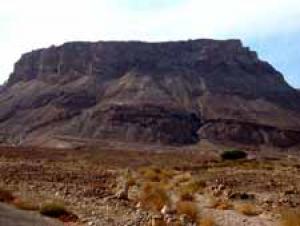Herod's Masada
Herod built the fortress-palace of Masada on a huge rock plateau overlooking the Dead Sea in the barren, remote, Judea Wilderness.
Protection
The top of the plateau, being more than twenty acres in size and nearly 1,300 feet above sea level, provided great protection. Around the top of the mountain, Herod's workmen constructed a wall nearly twenty feet high and twelve feet wide. Atop the wall, he built thirty-seven lookout towers.
On the east and west, strong gates were constructed where the paths entered the fortress. Herod also built cisterns and storehouses for everything needed in the even of a siege.
The Northern Palace
The upper terrace featured lavish living quarters with mosaic floors, frescoed walls, and a semicircular balcony that offered spectacular views. The round, middle terrace had two concentric rows of columns that created a beautiful balcony for relaxation.
The lower terrace, surrounded by low walls and columns with a roof in between, provided an open court inside a colonnade. A bathroom on its eastern side had hot, warm, and cold baths as well as mosaic floors. The great retaining walls that supported this level remain testimony to the genius of Herod's engineers.
The Western Palace
The western palace at Masada was Herod's official royal residence. Occupying more that 37,000 square feet, this building included royal apartments, bathrooms, a cold-water pool, and a large reception hall with magnificently decorated mosaic pavement.
The Ruins
The ruins of Herod's constructions of Masada underscore his devotion to himself. Providing for his own safety, satisfying his need for the finest luxuries, and establishing a name for himself were his obsessions. His presence provides an important dimension of the setting in which God placed Jesus. Could anyone believe Jesus was Messiah, Son of the Most High, when he appeared so ordinary compared to Herod?




